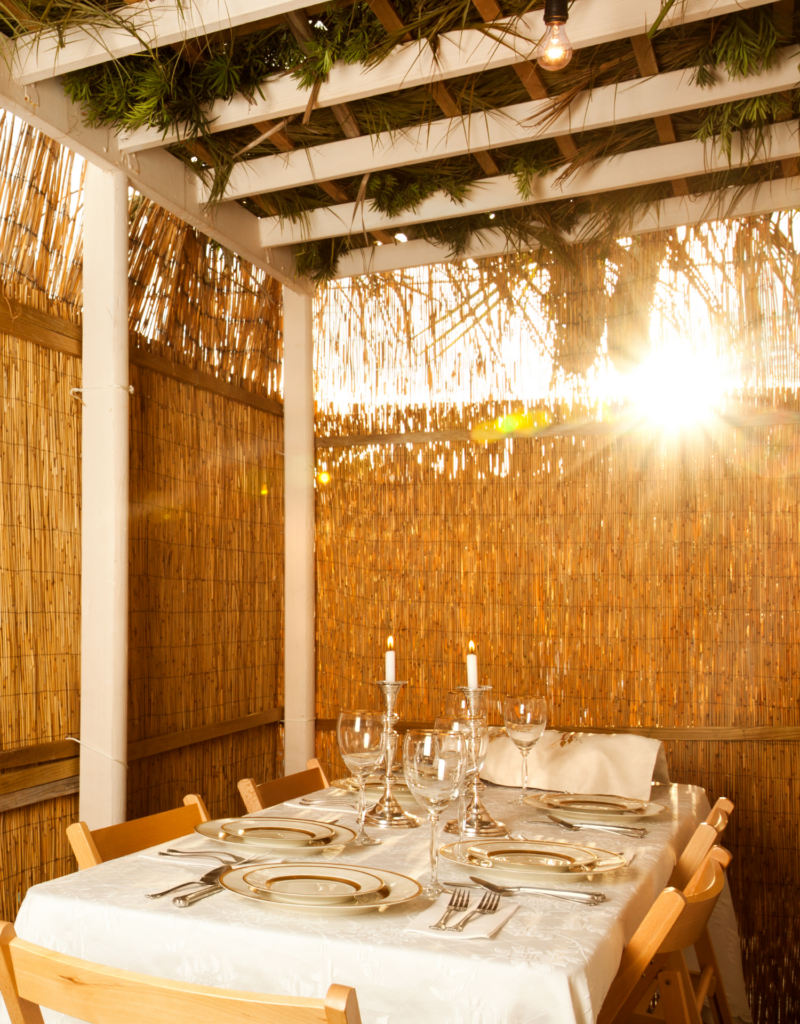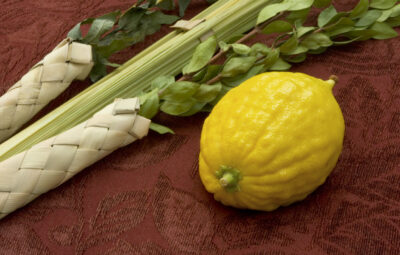
Rabbi Lily Solochek (RRC '20)
Director of the Wenger-Markowitz Family Education Initiative for Reconstructing Judaism
Sukkot has been my favorite Jewish holiday since I was a child. After the introspection of the High Holidays, Sukkot offers a chance to direct our attention outward, to the crisp autumn air, the changing leaves and the celebration of the harvest.

I have many fond memories of decorating our sukkah with paper chains (which always got soggy in the Oregon rain), hanging gourds and fruits, and dressing up as the ushpizin (biblical guests that we invite to the sukkah). After many years as an adult of living in apartments without outdoor space, my wife and I finally got the opportunity to build our own sukkah a few years ago. We decorated it with art and colorful lights, and invited friends and family to fill it with laughter and delicious food. We used branches and corn husks from our land to cover the roof.
Jewish tradition has a lot to say about how to build a sukkah: how many walls, how tall, proper material for the roof and more. For example, it cannot be taller than 20 cubits (about 30 feet), and it cannot be shorter than 10 handbreadths. The Talmud provides various explanations for the dimensions and when we look at these requirements through a Reconstructionist lens, we see that the laws of sukkah construction can teach us powerful lessons about how to build communities of belonging.
For example, according to the Talmud, the sukkah cannot be more than 20 cubits tall because it must be short enough to be able to constantly see the roof and remember how our ancestors traveled and slept in sukkot (plural of sukkah) in the wilderness. From this, we learn the importance of collective memory. What stories do we share in our community and how do they build a culture of belonging?
Additionally, the Talmud is worried that if the walls are too high, we will sit in the shade of the walls instead of the shade of the roof. On the one hand, shade is shade! Why does it matter if it’s roof-shade or wall-shade? Let us consider here the intention versus the impact. The Torah wants us to remember our wandering by sitting in the shade of the roof’s branches. We could take a shortcut, build a tall wall or create shade in another way, but that would go against the Torah’s intention, even if the impact were the same. When we mindfully consider all the people in our community and create truly accessible spaces, we cannot take shortcuts or rely only on impact; we must also consider our intentions and ensure those align with our values.
What if each person in our home, school, synagogue or havurah was greeted as a lofty guest? How might we set up our spaces so that everyone — whether it is their first time or hundredth time — felt welcomed as a holy guest?

My favorite part of this passage of Talmud is the conversation about the minimum dimensions. Rav Huna says the sukkah must be four cubits by four cubits, creating one measurement that everyone should use. Rav Hanan bar Rabbah says it must be big enough for the person’s head, most of their body and their table, presenting us with the reality that most spaces are not “one size fits all.” This second explanation reminds us to think about how different bodies need different types of spaces: Some might be taller or shorter, some larger or smaller, some might need more space for their tables than others. While Rav Huna’s measurement is “easier,” it ignores the needs of the individual; Rav Hanan’s statement encourages us to account for each person and create a space that fits them.
Additionally, the sukkah cannot be less than 10 handbreadths tall. The Talmud explains (Sukkah 5a) that this is because the Divine Presence does not descend fully to the ground. In order to include the Holy One in our sukkah, we must make it tall enough! With the understanding that Reconstructionist Judaism holds many different understandings and experiences of God, this passage reminds us that building accessible communities requires us to consider the needs of everyone and design the space to welcome them. Since we treasure the Divine Presence, we start by creating a space that is tall enough for God to join us. This is not accommodation to fit an already existing space or set of communal norms, but rather creating an inclusive space from the start. We do not build a sukkah at nine handbreadths and ask God to put in the extra work to fit inside; instead, we set out in partnership together to create a sukkah that is accessible to all.
Finally, many have the custom to welcome the biblical guests (Abraham, Isaac, Jacob, Joseph, Moses, Aaron, David, Sarah, Miriam, Deborah, Hannah, Abigail, Huldah, Esther) to the sukkah. Our family also has the custom of inviting other people (historic or modern figures, fictional characters, etc.) to the sukkah as well, invoking their qualities and strengths to join us for the holiday. The traditional declaration says, “Sit, sit, lofty guests; sit, sit holy guests; sit, sit guests of faith.” What if we welcomed everyone into our communities this way? What if each person in our home, school, synagogue or havurah was greeted as a lofty guest? How might we set up our spaces so that everyone — whether it is their first time or hundredth time — felt welcomed as a holy guest?
Sukkot is a time of hospitality and celebration. Let us learn from the construction of the sukkah that it is possible to design and create a world that is accessible and inclusive to all. Together, let us create spaces where everyone knows they belong and where we greet each other as holy guests.











